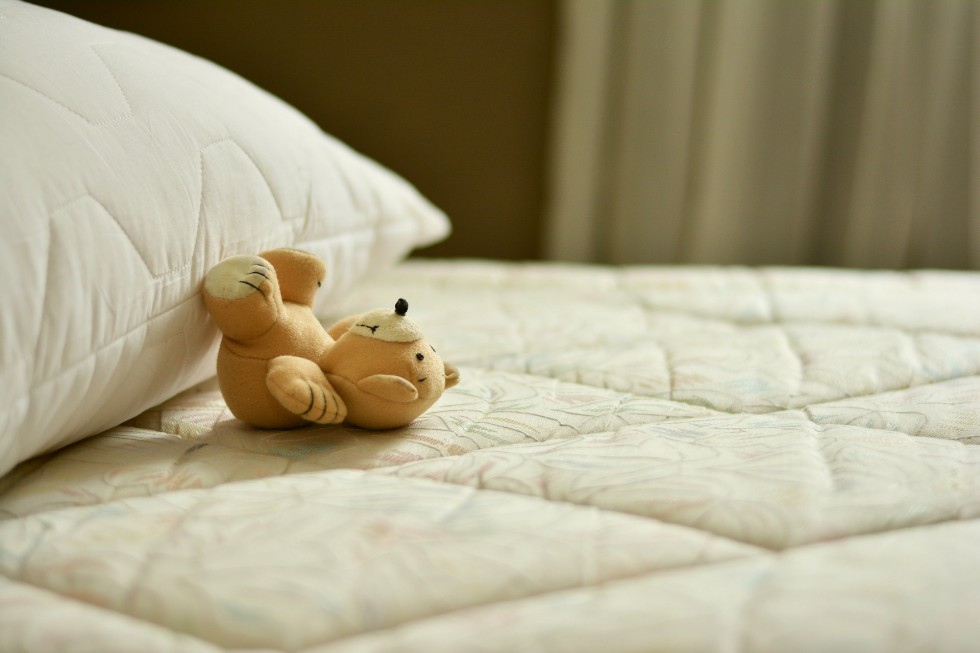We’re used to changing our bed sheets at least once a week. That’s a normal thing most people really enjoy.
But when it comes to our mattresses, they may remain abandoned for quite a while until we notice an unbearable odor, too ugly stains or, the worst out of the worst, bed bugs or mites.
In order to avoid that situation, it’s better to have a mattress cleaning routine and carry it out regularly. Maybe, not each time you change your sheets.
But biweekly or monthly cleaning will keep your matrasses well-maintained and safe to sleep on.
And, considering the fact that conducting an ordinary mattress cleaning is not nearly as difficult as you could imagine, you may totally add this point to your deep cleaning schedule.
Step-by-step mattress cleaning guide
- So, the first step is quite obvious – you need to have the access to your mattress.
Remove your duvet, pillows, bed sheets and mattress cover if you have one. Wash all the washable items to end up with the freshest bed in the world once you’re done. - Shake your blankets, duvets and pillows to get rid of the dust that’s accumulated in them overtime.
If you have a chance, let those items sit outside for a couple of hours to air out. This should help with getting rid of that musty smell they pick up in the course of time. - Most comforters, duvets and pillows might be washed in an ordinary washing machine that has a drum that’s big enough to hold them when they’re wet.
If yours don’t belong to that group, you may drop them off at the drycleaners.
Remember, that you’re supposed to change your pillows and even comforters after a couple of years. The term of their use is normally mentioned on the packaging.
So, don’t throw it away until you write down the date when you’ve purchased your comfy bed items and the approximate date of their ‘retirement’. - Pull out your ordinary vacuum cleaner and start vacuuming your mattress thoroughly.
Take your time and move the brush slowly to let the vacuum suck in as much dust as possible.
An upholstery vacuum cleaner brush will make the process much more efficient - Don’t forget to go over the mattress’s edges.
A hand vacuum cleaner or a narrow vacuum cleaner nozzle attachment will help you get into the smallest slots around the mattress’s ribs. - After that’s done, it’s time to proceed to DIY deep mattress cleaning. Our bodies have their natural smell, which is also ‘improved’ by the sweat odor.
That gets through our bedding right onto the mattresses. Combine that with occasional spills, spots, dust accumulation … and you’ll understand why your beds turn into odor mess overtime. - So, in order to get rid of that funky smell and pull even more dirt and dust out of it, we need to conduct the deodorizing procedure.
Basically, it’s advanced mattress vacuuming preceded by baking soda treatment.
- Just take your baking soda and sprinkle it generously all over the mattress. Don’t go overboard though. You may work it deeper into the mattress with the help of a scrubbing brush.
Try using it on a hidden spot of your mattress to make sure that you won’t damage the fabric with it before moving onto the main part of the mattress. - This step is completely optional and may be taken before the previous one.
Pour your baking soda into a large bowl and add a couple of essential oil drops (lavender works the best) to it if you want your mattress to have a nice delicate aroma. - Let that soda cleanser work for 10-15 minutes. Go back to precise vacuuming after that. (Don’t forget to clean the brush after the first session).
The way this method works is that baking soda absorbs the moisture which makes your bed smell so disgustingly. And, once it does its job, you remove it from the mattress together with the baking soda.
Voila! No smelly mattresses in your house anymore. - If you’re good at taking frequent and regular care of your mattress, you may avoid baking soda treatment.
Commercial deodorizing spray will do the job for you. - When you’re done with the first side of the mattress, flip it over to the other side and repeat the procedure starting from the step 4.
- If you’re lucky enough not to have any stains on your mattress, the cleaning is over for you. However, if you have a couple of annoying spots that ruin the look of your mattress, you may totally find the way to remove them.
For instance, table salt, hydrogen peroxide and dish soap mixture works great against the blood spots on upholstery.
If you want to know how to clean pee out of your mattress, change only one ingredient in that solution (use baking soda instead of table sault). You’ll end up with effective urine stain remover.
Visit Pintrest.com to learn more about DIY mattress stain removers. - If you don’t want to deal with those stains and heavy mattress pollution, make sure to protect it with a special fabric stain and moisture resistant cover.
- Don’t forget that it’s better to get your mattresses deep cleaned professionally.
Go to HireRush.com and create a mattress cleaning task to notify local companies/individual providers or call them directly from the website.
You may address a local mattress cleaning company to receive according services or get your mattresses treated along with your carpets, couches and other upholstery. Leave a task here






Great tips! been using this method too and I can say it works great! I have been using lysol too. Have you tried it?
Glad you liked them! Take a look at the rest of our posts to learn even more useful tips.
I haven’t tried Lysol, but I’m sure that any good quality mattress cleaning spray will do a great job. I just prefer to stick to that traditional method I’ve described in my post. Takes a little bit more effort, but works amazing and requires minimum supplies.
Cleaning your mattress is essential for a healthier sleep environment and to prolong its lifespan. Start by stripping the bed and washing your bedding in hot water to kill dust mites and bacteria. Vacuum the mattress surface thoroughly to remove dust, dead skin cells, and other debris. For stains, use a mixture of mild detergent and water, or try natural solutions like baking soda and vinegar. Allow the mattress to air dry completely before remaking the bed. Regular maintenance like this can keep your mattress fresh and hygienic for years to come.